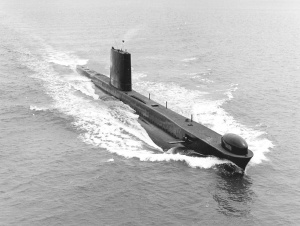HMS Rorqual (S02)
 HMS Rorqual (S02)
| |
| History | |
|---|---|
| Name | HMS Rorqual |
| Builder | Vickers-Armstrongs, Barrow-in-Furness |
| Laid down | 15 January 1955 |
| Launched | 5 December 1956 |
| Fate | Arrived for scrapping on 5 May 1977 |
| General characteristics | |
| Class and type | Porpoise-class submarine |
| Displacement |
|
| Length | 290 ft (88 m) |
| Beam | 26 ft 7 in (8.10 m) |
| Draught | 18 ft (5.5 m) |
| Propulsion |
|
| Speed |
|
| Range | 9,000 nmi (17,000 km) at 12 kn (22 km/h) |
| Complement | 71 |
| Armament |
|
HMS Rorqual (S02) was a Porpoise-class submarine launched in 1956. She was built by the Vickers shipyard in Barrow-in-Furness, Cumbria, England. The boat was named for both the rorqual, a family of whale, and the earlier Second World War-era submarine of the same name.
Design and construction[edit]
The Porpoise-class was the first class of operational submarines built for the Royal Navy after the end of the Second World War, and were designed to take advantage of experience gained by studying German Type XXI U-boats and British wartime experiments with the submarine Seraph, which was modified by streamlining and fitting a bigger battery.[1][2][3]
The Porpoise-class submarines were 290 feet 3 inches (88.47 m) long overall and 241 feet 0 inches (73.46 m) between perpendiculars, with a beam of 26 feet 6 inches (8.08 m) and a draught of 18 feet 3 inches (5.56 m). Displacement was 1,565 long tons (1,590 t) standard and 1,975 long tons (2,007 t) full load surfaced and 2,303 long tons (2,340 t) submerged.[1] Propulsion machinery consisted of two Admiralty Standard Range diesel generators rated at a total of 3,680 brake horsepower (2,740 kW), which could charge the submarine's batteries or directly drive the electric motors. These were rated at 6,000 shaft horsepower (4,500 kW), and drove two shafts, giving a speed of 12 knots (14 mph; 22 km/h) on the surface and 16 knots (18 mph; 30 km/h) submerged.[4][3] Eight 21 inch (533 mm) torpedo tubes were fitted; six in the bow, and two in the stern. Up to 30 torpedoes could be carried, with the initial outfit consisting of the unguided Mark 8 and the homing Mark 20 torpedoes.[1]
Rorqual was laid down at Vickers-Armstrongs' Barrow-in-Furness shipyard on 15 January 1955, was launched on 5 December 1956 and completed on 24 October 1958.[1][4]
Service[edit]
In 1958, Rorqual experienced a fire.
In February 1960, Rorqual visited the Mediterranean, calling at La Spezia in Italy and Nice in southern France before returning home to Faslane at the end of the month.[5] In 1963, she was caught in a trawler's net. An explosion in 1966 killed one junior rate and injured the chief of the watch, who died ashore at Inhambane, Rorqual was off the coast of Mozambique en route to Singapore. In 1969, Rorqual rammed a moored minesweeper, USS Endurance (MSO-435) while docking at River Point pier in Subic Bay, Philippines. The collision punched a large hole in Endurance's hull but did not damage Rorqual. At the time of the incident, Rorqual was commanded by Lieutenant-Commander Gavin Menzies who retired the following year and later published the controversial book 1421: The Year China Discovered America.
Rorqual won the SOCA Efficiency trophy in 1973.
Rorqual arrived at the Laira breaker's yard near Plymouth on 5 May 1977. She was broken up by Davies & Cann.
References[edit]
- ^ a b c d Gardiner & Chumbley 1995, p. 529
- ^ Brown 2012, p. 116
- ^ a b Brown & Moore 2012, p. 114
- ^ a b Blackman 1971, p. 339
- ^ "We may have been cleaned out—but the system works: Rorqual Finds La Spezia Weather Just Like Faslane". Navy News. April 1960. p. 11. Retrieved 23 September 2018.
Sources[edit]
- Blackman, Raymond V. B. (1971). Jane's Fighting Ships 1971–72. London: Sampson Low, Marston & Company. ISBN 0-354-00096-9.
- Brown, David K. (2012). Nelson to Vanguard: Warship Design and Development 1923–1945. Barnsley, UK: Seaforth Publishing. ISBN 978-1-84832-149-6.
- Brown, David K.; Moore, David (2012). Rebuilding the Royal Navy: Warship Design Since 1945. Barnsley, UK: Seaforth Publishing. ISBN 978-1-84832-150-2.
- Colledge, J. J.; Warlow, Ben (2006) [1969]. Ships of the Royal Navy: The Complete Record of all Fighting Ships of the Royal Navy (Rev. ed.). London: Chatham Publishing. ISBN 978-1-86176-281-8.
- Gardiner, Robert; Chumbley, Stephen, eds. (1995). Conway's All The World's Fighting Ships 1947–1995. Annapolis, Maryland, USA: Naval Institute Press. ISBN 1-55750-132-7.
- Hennesey, Peter; Jinks, James (2016). The Silent Deep: The Royal Navy Submarine Service since 1945. Penguin. ISBN 978-0-241-95948-0.
